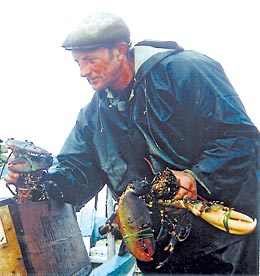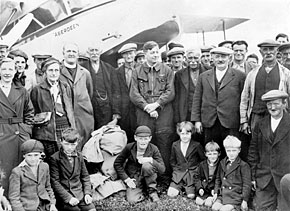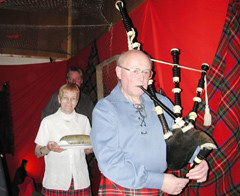When I was writing one of my letters to The Orcadian in September, I referred to the BBC Restoration Village competition and of how, at that time, the Dennis Head Beacon had won the Scottish entry.
As everybody now knows the island went on to take third place overall – a noteworthy achievement indeed.
The BBC Restoration programme obviously captured the imagination of many people. There is, without doubt, an undeniable romance and mystique connected with lighthouses: the history of their construction; their eye-catching, elegant design; their presence round the coastline of Scotland, England, Wales and Ireland, and, of course, their guidance to shipping with the familiar motto ‘For the Safety of All’.
People voted for the Beacon up and down the land, and as a result great publicity was achieved for the island with whatever benefits it might bring.
The final restoration plan for the Beacon seems to be as follows:
* The restoration of the tower with a new stairway giving access for tourists to the top;
* The outside and inside of the tower to be picked and pointed with doors and windows replaced.
* A “green road”(?) to be constructed between the public road and the Old Beacon.
* The restoration of the ruined cottages with finished interiors which will include box-beds etc — forming what is described as a living museum.
* Water, electricity, public toilet facilities and lighting systems will be installed.
* A replica lantern will be constructed at ground level.
Another part of this restoration package is the repair of the New Lighthouse pier (still in use locally for fishing activities) some distance away – a necessary, and easily achievable piece of work. Of course, those structures are listed with an A listing for the Beacon.
In my letter I merely touched on another word used by those who have responsibility for ancient monuments in England and Scotland.
That was the word conservation – quite a different word from restoration.
I had hoped there could have been a debate within the island as to which of those two might have been chosen or preferred by islanders.
Hopefully, this debate will be undertaken by Historic Scotland. I also, in the letter, mentioned the name of William Morris, who was responsible for establishing the Society for the Protection of Ancient Monuments in England in 1877. He argued very strongly for conservation rather than restoration.
Here is one of his ideas that might, I think, be worth considering:
“If it has become inconvenient for its present use, to raise another building rather than alter or enlarge the old one; in fine, to treat our ancient buildings as monuments of a bygone art, created by bygone manners…”
The original plans for the tower and the lightkeeper’s accommodation show the tower to be only 26 feet in height, though in the ‘agreement’ with the two masons, John White and James Sinclair, Kirkwall, it says the tower shall be 60ft high.
The thickness of the tower wall (in the plan) is 3ft 9in at the base narrowing to 3ft at 26ft.
A measurement taken at the actual base appears to be some inches over 4ft – ensuring more strength. The plan details a solid stone stairway. The steps (sandstone) were broken down at a later date in order to prevent access and little now remains.
The plan for the lightkeeper’s cottage shows only one house. In fact there are two, with the west-most facing house having been added, possibly at a later stage – the division between the two is clear and there is no connecting doorway.
From close observation the remains of Welsh slate can be seen at the point of abutment with the tower, which would indicate that roofing was of Welsh slate.
Measurements of the remains of the two joined houses indicates that what was built (excluding the second building) does not match the plan.
However, those inconsistencies and lack of every detail, may not have been unusual in the early days when the first four experimental lighthouses were built.
There is no indication of the interior finish – box beds etc – though we know that a box bed was acquired by a farm on the island after the vacation of the building.
The restoration of the joined buildings, and the interior, will therefore be restored, it seems to me, based on conjecture rather on proof.
The keeper’s house was still intact in 1871 when a local family connected with lighthouse work – the New Lighthouse (lit 1854) – was recorded in the census as living there. Shortly after this the building was vacated and, presumably, the roof removed at the same time.
So far, seriously missing from the Beacon’s history, as presented to the public, is the very obvious fact that the structure is extremely vulnerable to heavy sea.
Certainly, it has often been said that during the inhabited lifetime of the living quarters, the sea entered the buildings on more than one occasion causing the inhabitants to leave.
Today, it is very evident that sea-thrown stone has piled up on the seaward side of the buildings so that the floor of the dwelling houses varies from being 1ft 8in, to over 4ft below the outside surface.
One can see, for example, how unusually low the seaward-facing window in the first cottage is in relation to the outside ground level.
As recently as 1993 (when considerable damage was done to the A-listed sheep dyke) the wall of the sheep pund (trap) which borders the cottage buildings was partly demolished.
The dyke is really no distance from the building and without doubt, with the right combination of sea, wind and the height of a stream tide, water would have been sweeping through the area.
With the predictions of global warming and subsequent rising of sea levels this problem will probably become much worse as the years pass.
The Old Beacon tower is quite sound and stands as straight as the day it was built (John Sinclair, former OIC building inspector, now deceased, stated in a report written in 1995: “As it stands at present, it would be reasonable to assume that further deterioration of the structure would be minimal and I would fully expect the Beacon to be structurally sound in another hundred years”).
The masonry ball which so elegantly crowns the tower also appears to be sound.
The masons who placed the ball on the top of the tower certainly knew, one would think, what they were about.
To have remained in place for 200 years – come 2010 – is surely proof that it is on the rather unique design of the stone base upon which the cone and ball stand that everything depends, not on the visible, seemingly fragile, few wood timbers.
However, a proper survey by an architect or civil engineer should confirm the durability and construction methods employed to build the supporting structure and whether, in fact, there is a problem.
Health and safety requirements to allow tourists up on the top would certainly seriously alter the elegant lines of the top structure and the architectural balance of the tower.
In fact, I should think that the top stone work would have to be changed (almost re-built in fact) to allow sufficient width for a safe walking passage-way and to provide some form of secure base into which suitable railing could be securely fixed – both to prevent falling from the top and prevent access up to the masonry ball.
In any event, what is the point of climbing another tower when the New Lighthouse commands a spectacular view at almost twice the height (139 ft) and boasts the highest land-based lighthouse in the British Isles?
After all, we are talking about an unlit beacon which was not designed for sight-seeing from the top.
Why sacrifice the aesthetic appeal of the tower for an unnecessary balcony?
Two eminent Scots have both publicly stated that the top of the Dennis Head Beacon should not be compromised: Professor Roland Paxton MBE FRSE (The Scotsman, July 27, and Margaret D. Street MBE FSA (Scot.) The Orcadian, August 31).
Roland Paxton, teacher, researcher, writer and honorary professor at Heriot Watt University, along with Jean Leslie wrote the book Bright Lights – The Stevenson Engineers 1752 – 1971.
He is a Fellow of the Institution of Civil Engineers, a former chairman of its panel for Historical Engineering works and commissioner on the Royal Commission on the Ancient Historical Monuments for Scotland.
Margaret Street is a former chairman of the Saltire Society, and a life member of the Orkney Heritage Society, having been involved in raising money for St Magnus, the conservation of Papdale House and the Strynd.
She has also been involved, and still is, in the commemorations of Samuel Laing and John Rae. In addition, the preservation of the North Carr Lightship, Wallace statue and many other commemorative project achievements, can be listed in a lifetime of dedicated work for Scotland’s heritage.
What many of us on the island and elsewhere would like is a professional inspection of the tower, with scaffolding erected outside and inside, with the purpose of checking on the top structure and making sure that the crowning masonry ball remains safely in place for the foreseeable future.
In addition, we would want what remains of the dwelling houses to be preserved in their present state.
Weather-resistant outside display boards, now commonly in use at historic sites, could be installed with a general tidy-up of the area.
The buildings could be cleared from fallen stone, and beach stone thrown in, from time to time, by over 200 years sea invasion.
An easy, safe access to the buildings; a ‘cleaned out’ tower, made secure against further bird invasion would be necessary.
There is also, of course, the immediate repair of the Lighthouse pier – a real south-easter would certainly inflict more damage.
The argument put forward that the Old Beacon project would secure a glowing future for North Ronaldsay needs to be debated.
It would, no doubt, increase tourism but it does not solve the one pressing, serious problem that the trust, along with the community council, should be addressing even more vigorously – lack of housing, jobs, and young families.
With about 34 of the present population of 60 inhabitants over 60; five in the 50 – 58 category and around nine aged 30-50, it’s time to concentrate on the three essential requirements mentioned above.
An ambitious programme of change and development is slowly going on at the New Lighthouse, costing many thousands of pounds.
In explanatory trust literature and the BBC Restoration programme, the Old Beacon is mentioned, along with the development of the New Lighthouse.
I was thinking, therefore, that, perhaps, instead of attempting to restore those vulnerable cottages, Morris’s idea mentioned above could be considered.
This could be a carefully-designed interpretation centre constructed entirely separate from the Old Beacon. Additional exhibition space would be gained and such a building, with modern amenities, would be safe from sea invasion.
The Old Beacon is spectacular – provided the masonry ball remains in place. It always has been so and will always attract visitors, as presently does the New Lighthouse.
Once the National Trust for Scotland promotes the two high-quality, self-catering houses planned for the New Lighthouse many more people will be tempted to visit the island.
The full restoration programme will, to my mind, most certainly change the appearance of this familiar and enduring monument and the unique atmosphere of the Dennis Head area created by the passage of time.
There is a continuity there of landscape, ancient stonework backed by the sea and sky in every colour and mood. I was there recently making some studies of the beacon.
![]() A drawing of the Dennis Head Old Beacon on North Ronaldsay,
A drawing of the Dennis Head Old Beacon on North Ronaldsay,
by Ian Scott.
Before I left, the moon was rising behind the dark tower and ruined buildings. The scene was truly magnificent.
As an artist working in North Ronaldsay, these past 44 years, I would be very disappointed if any of those irreplaceable icons were to be unnecessarily lost without a full and open debate with the people of the island.
I hope that Historic Scotland will look very carefully at any changes proposed to the Old Beacon.
It is a monument of national importance, familiar to generations of islanders and passing mariners.
There it stands on the Dennis Head peninsula, an imposing landmark and, I hope, a lasting memorial to Thomas Smith, the engineer, and those masons and builders who built it there over 200 years ago.
Let me now, if I may, comment on another island issue that has featured prominently, recently in The Orcadian. Since it has generated much discussion on and off the island, perhaps it should be mentioned. Certainly, it merits further open debate.
Once, North Ronaldsay was almost self-sufficient. It was an adventure to get to the island and, once here, there was a real sense of island life and this is something we need to preserve.
Its population in the 1930s was around 283 and by the 1960s still over 130. The island was served for a time by a steam ship sailing once every two weeks in the winter, once a week in the summer and run by a company that had to balance its books at the end of the year.
Nowadays, we hear, it costs millions to subsidise the running expenses of the ro-ro system. Will this support continue I wonder?
On steamer days, in the summer time, the pier was covered with tons of unloaded cargo with many islanders’ goods waiting to be shipped.
Today, as a result of a seriously depleted population, the turn-about time of our weekly ferry can be as short as 35-45 minutes.
Indeed, one might ask whether the weekly, wintertime, freight trip is justifiable in terms of time and oil spent.
Are all those many scheduled trips to the other islands that we read about really sustainable? Is this the only way for the islands to survive?
What, for example, is the breakdown on cargo shipped here and there and what is the revenue generated? And the problem, if it is indeed one, of getting certain types of material out to the island in a timely fashion could perhaps be resolved with better planning and negotiation.
During the summer months, we have three planes per day for seven days, with a freight plane carrying perishables once a week.
More planes are being asked for, plus extra freight flights – even night-time flights are being considered. A second ferry in the week (summer time) has been requested. It’s argued that this is essential. But, once implemented, will this then lead to more planes, more boats, more cars, more tourists?
Is that what the island really wants? Let us be careful that we don’t kill the goose that lays the golden eggs and destroy the real values of island life.
I reiterate the three essentials which most islanders agree are vital if this island is to survive – houses, jobs and young families.




